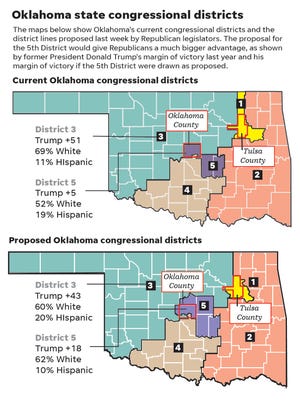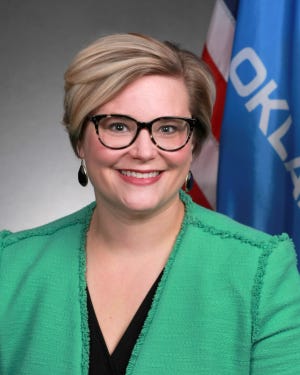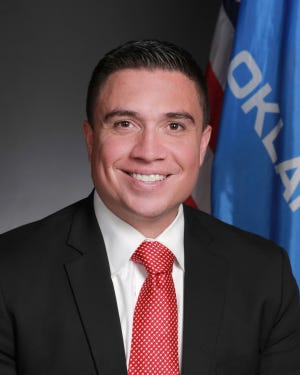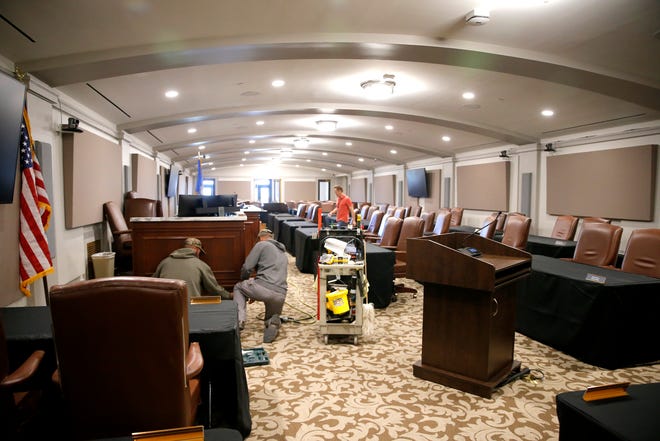11.14.21 – Oklahoman —
State lawmakers will return to the Oklahoma state Capitol on Monday for a weeklong special session on redistricting.
Lawmakers are tasked with approving new maps for Oklahoma’s five congressional districts, 48 state Senate districts and 101 House districts.
Related:Oklahoma special session won’t address COVID-19 vaccine mandates, a divisive issue for GOP
The five-day special session could turn contentious because Democrats have criticized the proposed 5th Congressional District map, saying it was intentionally redrawn in a way to limit competition and keep U.S. Rep. Stephanie Bice safe in her seat.
Democrats have small minorities in the Oklahoma Legislature, and the GOP-backed maps are likely to pass despite their opposition.
Here’s everything you need to know about the special session.
Related:Despite GOP claims, public did not favor carving up Oklahoma County

Why are Oklahoma lawmakers holding a special session?
U.S. Census Bureau delays in delivering redistricting data to states necessitated the special session.
Every decade following the census, Oklahoma state lawmakers redraw legislative and congressional boundaries based on population shifts.
Related:Here’s how much Oklahoma City has grown over the last decade, according to the 2020 Census
Traditionally, lawmakers complete the redistricting process in the spring, before the end of the annual legislative session. This year, the Census Bureau didn’t release final population data until mid-August, months after the end of the regular legislative session.
Why does the special session last a week?
Five days is the fastest lawmakers can move bills through the legislative process.
The redistricting bills will not be fast-tracked. They will go through the traditional legislative process that includes being heard in committee before being voted on by the full House and Senate.
Expect a partisan divide on the congressional redistricting map
Legislative Republicans and Democrats are likely to be divided when it comes to voting on the proposed congressional map.
The map, put forth by the GOP heads of the House and Senate redistricting committees, has been widely panned across the aisle.
Democrats have criticized proposed changes to the 5th Congressional District that would shift heavily Democratic areas of Oklahoma City out of Bice’s district and into the 3rd Congressional District that covers most of northwest Oklahoma, including the Panhandle.

The proposed map would move about 181,000 Oklahoma County residents in the 5th Congressional District to the 3rd Congressional District.
Major shifts include much of southwest Oklahoma City, which has a large Hispanic population, and parts of the city just northwest of downtown, including the Plaza District, which would move to the district represented by U.S. Rep. Frank Lucas, R-Cheyenne.
With the 5th District shedding part of Oklahoma City, the map proposes adding parts of Canadian, Logan and Lincoln counties to the district that would continue to cover parts of Oklahoma, Pottawatomie and Seminole counties.
Related:Congressional map would carve up Oklahoma City, help GOP
House Minority Leader Emily Virgin, D-Norman, said the most logical way to draw the map would have been to keep the 5th District solely in Oklahoma County, which has just under 800,000 residents, or about one-fifth of the state’s population.
“What we’ve seen are maps drawn specifically to protect incumbents in Congress, and that should not be the goal of redistricting,” she said.

Looking at the map holistically, there are few major changes, said Rep. Ryan Martinez, R-Edmond, chairman of the House State and Federal Redistricting Committee.
“There are currently three Congress people from Oklahoma City right now,” Martinez said when the redistricting maps were unveiled. “After this map passes, there will still be three congressional people representing Oklahoma City.”
As for the 5th District, the proposed changes largely stemmed from public input, Martinez said.
As an example, he pointed to Guthrie, where a local council member asked that because of Edmond’s close ties with the city and Logan County, both areas be included in the 5th District. Guthrie, which is not currently in the 5th District, would be added under the proposed map.

House Speaker Charles McCall, R-Atoka, has defended the congressional map and refuted accusations that it was gerrymandered to give Republicans a better chance of retaining the only competitive seat in the state.
In praising the map, McCall said it was the result of months of public input and an apolitical process.
Several Democrats are considering introducing amendments during the special session to change the proposed congressional boundaries, Virgin said.
Some Democrats may also introduce bills to make the redistricting process more transparent, she said.
Republican majorities in both chambers likely have the votes to block any changes Democrats may propose.
“I know for certain that we will be voicing strong opposition and trying to convince our colleagues that this is not the right way to go,” Virgin said.
Little debate likely on legislative maps
State lawmakers easily passed and Gov. Kevin Stitt approved new legislative maps in the spring.
However, lawmakers will have to approve revised legislative maps in the special session that were redrawn based on the latest census data.
The House and Senate redistricting maps sailed through the Legislature once before and these new maps are likely to follow the same path.
Related:Oklahoma lawmakers unveil updated House, Senate redistricting maps
Redistricting leaders have said the new legislative maps are similar to what passed the Legislature with bipartisan support in May.
Virgin said she doesn’t expect pushback to the new House and Senate maps.
“We’ve had more time to have those maps out in the public and get feedback about them because they were released back in May,” she said. “They’ve been out there for a while and we’ve heard from out constituents on them, so we feel more confident in those.”
No incumbent lawmakers were drawn out of their districts in the proposed legislative maps.
Changes coming to residency requirements
Lawmakers will also vote on bills to update the residency requirements for legislative and county commissioner candidates.
Under proposed legislation, candidates must be registered to vote by Dec. 31 in the district in which they intend to run.
More:Redistricting delays create uncertainty for political candidates anxious to run for office
Previously, contenders would have been required to be a registered voter in their district for six months before the start of candidate filing on April 13, 2022.
The change lawmakers are proposing would give candidates more than a month to move districts and establish residency after the new redistricting maps are adopted.
Some candidates might be inclined to move if switching districts could improve their chances of winning in next year’s elections.
Capitol logistics create complications
Because of ongoing Capitol renovation work occurring in both legislative chambers, House and Senate floor sessions have been moved to different parts of the building.
The changes mean that because of space limitations, there will be limited public seating to watch floor proceedings, although livestreaming options will be available.
All 48 senators will gavel in daily from a makeshift chamber on the fifth floor of the Capitol.
House legislators, all 101 of them, will cram into a first-floor room that Republicans traditionally use to caucus and whip votes. The public will not be allowed to enter the room.

Typically, when the House and Senate are in session, members of the public are free to watch proceedings from the gallery, coming and going as they please.
All special session proceedings will be livestreamed at okhouse.gov and oksenate.gov.
